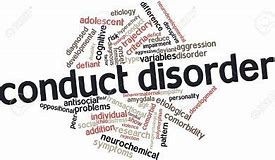
 Mood disorder by definition is related to a psychological disorder characterized by the elevation or lowering of a person’s mood, such as depression or dipolar disorder. Mood disorder is a biochemical change that may develop at puberty and is connected to the child’s emotions (Vigil, Orellana & Cortes, 2011). There are many forms of mood disorders. This paper will form a better understanding of each in children and discuss possible treatments and interventions.
Mood disorder by definition is related to a psychological disorder characterized by the elevation or lowering of a person’s mood, such as depression or dipolar disorder. Mood disorder is a biochemical change that may develop at puberty and is connected to the child’s emotions (Vigil, Orellana & Cortes, 2011). There are many forms of mood disorders. This paper will form a better understanding of each in children and discuss possible treatments and interventions.
Childhood Depression
With each day that pass, children and adolescents may experience mood swings such as grouchiness, moodiness, and reluctance to go to school. These are all common behaviors in young people at some stage of childhood or adolescence. These behaviors can sometimes signal a more serious problem than “growing pains”. Illnesses like depression or bipolar disorder is considered when the child’s behavior is prolonged.
The study of mood/depressive disorder, in children and adolescents is fairly new. Today, there is as many as 5% of adolescents who suffer from depression at some point in time. About 20% of adolescents will experience meaningful symptoms of depression by the time they reach adulthood. Mood swings and depression can start from the onset of puberty between the age of 15 and 24, where emotions and mood swings are at its highest. (Regents University of Michigan, 2003- 2014). Sometimes the signs that a child is suffering from depression isn’t as clear. A parent could attribute a child’s behavior as being stubborn, the child could be challenging the parent’s authority, onset of puberty in girls, or it could be signs of something more server such as mental illness like autism. It is best that the parent stays vigilant of their child’s developmental changes no matter how small, superficial, or mundane.
Bipolar Disorder
Another form of mood disorder is bipolar disorder. It is described as mood swings from extremely low depression to high mania (Miklowitz, 2001). According to World Health Organization, bipolar disorder is the sixth leading cause of disability in the world and it affects approximately 5.7 million adult Americans or about 2.6 percent of the U.S. population age 18 and older every year, according to the National Institute of Mental Health. Bipolar Disorder has faced various stages like Mood Episode, Manic Episode, Depressive Episode and/ or Mixed Episode.
According to the DSM- 5, Bipolar- I is characterized by the following episodes like manic depressive episodes. Because Manic episode is characterized as a condition in which people can go back and forth between periods of being extremely happy or irritable, the mood swings between mania and depression, can be very quick or could last as long as a week.
During a bipolar episode, a person may experience incoherent disconnected rapid secessions of thought, difficulty paying attention and staying focused, agitation, restlessness increase in activities engaging in on restraints behaviors with a high likelihood of negative outcomes such as gambling, unsafe sexual activities, impulse shopping, and getting into high-risk business venture. The person will experience a high level of agitation and worthlessness with difficulty concentrating and focusing (APA, 2000). If not managed, the person may begin to develop thoughts of suicide.
Comparing Bipolar and Mood Disorder with Children and Adults
Diagnosing children with bipolar disorder can prove to be difficult because the psychologist can mistake the disorder for Attention Deficit Hyperactivity Disorder, also known as (ADHD). Children may become more irritable than adults and are likely to experience psychotic episodes such as hearing and seeing things that aren’t really there. Children may also complain of physical aches and pains. The difference in bipolar disorder with children and adults is that the cycle or episodes last for a short period of time in children. Manic and depressive periods may be separated by weeks, months, or years in adults. Episodes can last a single day for children. In older teenagers, the symptoms and treatment of bipolar disorder are much more similar to those seen in adults. As they get older, teenagers might become resentful and more agitated if they feel that you’re imposing treatment on them (Kaufman, Martin, king, & Charney, 2001).
Possible Treatment and Intervention (Birmaher et al., 2007; Cheung et al., 2008).
• Follow the medication schedule: It is important that the child receives their medication and follow the directions of the doctor. The parent should keep track of any possible side effects and whether the child took the medicine on time. The school should not allow the child to take their own medication, it should be kept in the nurse’s office for proper tracking.
• Monitor side effects: Children are more prone to side effects from some of the drugs used for depression. Some side effects are weight gain changes, elevated levels in blood sugar, skin discoloration, headaches and elevated cholesterol levels. Ask your child’s doctor what symptoms to watch for. The FDA has issued a warning that using some types of antidepressants may increase the risk of suicide in children.
• Talk to your child’s teachers: Communication is imperative to assure stability in school. All members who are directly responsible for the child’s well-being must be informed. The child should take breaks when needed and be given less homework. If the child is having a difficult time, they may take walks with the In-Class Support Assistant.
• Keep a routine: It is important for children with bipolar disorder to follow a daily routine. Examples of routines would be the time for meals, homework, TV time, bath time, and bed time. An expected daily activity can help reduce stress. It is also important to help the child eat healthy meals and exercise every day.
• Consider family therapy: Children experiencing bipolar disorder can be a difficult experience for the whole family. It can put a strain on marriages and other siblings may feel isolated, ignored or resentful. Younger children may not understand what is going on with their brother or sister. Family therapy can help all members deal with and understand the issues.
• Take suicidal threats seriously: Unfortunately, depression can become so server that even children would consider suicide. Don’t ignore the signs. If the child is thinking about hurting themselves or are engaging in life threatening behavior, the parents should remove any possible weapons and prescription or over the counter drugs, then get help immediately.
Conclusion
Mood Disorder: Disturbances of mood that are intense and persistent (Butcher, Hooley & Mineka, 07/ 2013). Just like adults, children and adolescence will experience some form of depression in their daily lives. Examples would be when children don’t get picked for a team or get a bad grade on a test. Adolescence may experience a break up. These instances can bring on temporary depression or stress, certainly disappointment. It is important for parents and care providers to observe various moods and the length of time these mood swings last. Early intervention is the key to help a child/adolescent who maybe thinking of suicide.
References
American Psychiatric Association, (2000). Diagnostic and statistical manual of mental disorders, (4th ed.), (text revision). Washington, DC: American Psychiatric Association.
Birmaher, B., Brent, D., Bernet, W., et al. AACAP Work Group on Quality Issues, (2007). Practice parameter for the assessment and treatment of children and adolescents with depressive disorders. Journal of the American Academy of Child and Adolescent Psychiatry, 46, 503-526.
Butcher, James N., Jill Hooley, Susan Mineka. Abnormal Psychology, 16th Edition. Pearson Learning Solutions, 07/2013. VitalBook file.
Cheung, A. H., Zuckerbrot, R. A., Jensen, P.S., Stein, R. E. K., Laraque, D., & the GLAD PC Steering Committee (2008). Expert Survey for the management of adolescent depression in primary care. Pediatrics, 121, 101-107.
Kaufman, J., Martin, A., King, R. A., & Charney, D. (2001). Are child-, adolescent-, and adult-onset depression one and the same disorder? Biological Psychiatry, 49, 980-1001.
Miklowitz, D. J. (2001). Bipolar disorder. In D. H. Barlow (Ed.), Clinical Handbook of psychological disorders (pp. 523-561). New York, NY: Guilford Press.
Regents of the University of Michigan,( 2003-2014), The University of Michigan Depression Center.
Vigil, P., Orellana, R. F. & Cortes, M. E., et al (2011): Endocrine modulation of the adolescent brain: a review. J Pediatr Adolesc Gynecol, 24: 330-700.
Note: All opinions are welcomed. I completed this paper for a college assignment. To avoid plagiarism, no part of this assignment shall be copied or used, without the sole permission of the author. Thank you for your cooperation.
Copyrights © Catherine Tillery All Rights Reserved
























Comments